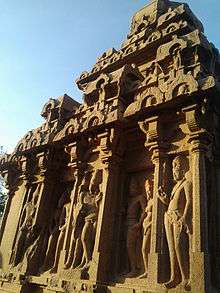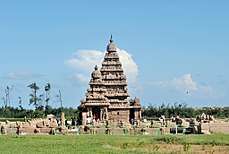Arjuna Ratha
| Arjuna Ratha | |
|---|---|
|
Arjuna Ratha | |
| Geography | |
| Country | India |
| State | Tamil Nadu, |
| District | Kancheepuram district |
| Location | Mahabalipuram |
| Culture | |
| Primary deity | Shiva |
| History and governance | |
| Date built | c. 650[1] Common era[2] |
Arjuna Ratha is a monument from the Pallava Period at Mahabalipuram, on the Coromandel Coast of the Bay of Bengal, in Kancheepuram district of Tamil Nadu, India. Dated to the seventh century, it is an example of early Dravidian architecture and of monolith Indian rock-cut architecture dating from the late 7th century during reign of King Mahendravarman I and his son Narasimhavarman I (630–680 AD) of the Pallava Kingdom. One of the Pancha Rathas,[3] it is believed to have been completed before the Dharmaraja Ratha, and like that and the Bhima Ratha, the stone temple is a replica of an earlier wooden version which preceded it.[3][4] It is one of the Group of Monuments at Mahabalipuram designated as a UNESCO World Heritage Site since 1984.[5]
Geography
The structure is located at Mahabalipuram (previously known as Mammallapuram) on the Coromandel Coast of the Bay of Bengal in the Indian Ocean, in Kancheepuram district. It is approximately 35 miles (56 km) south of Chennai (previously known as Madras), the capital city,[6] while Chengalpattu is about 20 miles (32 km) distant.[7]
History
The feature of this ratha and the other four cannot be definitely dated to any other similar constructions in the past in any ancient Indian architecture. However, the five rathas have been forerunners or templates for the development of Indian temple architecture. Like the other four Pancha Rathas, this stone edifice is a replica of a wooden version which preceded it.[4] Though it is considered to be a monolith temple, "temple" is a misnomer given that the five rathas were never completed,[8] as evidenced by uncarved bedrock at the pinnacle. Hence, the rathas were neither consecrated nor worship offered.[6] The incomplete status of all the five rathas is attributed to the death of the king Narasimhavarman I in 668 AD.[9][10] Even the epic Mahabharata name associated with the Pandavas is not supported by history.
Architecture
All of the Pancha Rathas are aligned in a north-south direction and share a common plinth which is north-south oriented and has a gentle slope. They have no precedent in Indian architecture and have proved to be "templates" for building larger temples in the South Indian tradition of Dravidian temple architecture.[10] Though cut out of monolithic rocks, they are carved in the form of structural temples in regular building form and hence termed as “quasimonolithic temple form”.

Layout
The ratha is a simple structure, resembling a small palace or pavilion. It is carved over an elongated stone rock formation, a protrusion above the sand near the coast (which has a gradually rising slope from the north end to the southern end) of a moulded plinth, with a square plan similar to the Dharmaraja Ratha. It faces west and measures 11.5 by 16 feet (3.5 m × 4.9 m) and is 20 feet (6.1 m) in height. It is on the same upapitha (secondary platform) as the Draupadi Ratha next to it.[9][11]
Features
This ratha is similar in form to the Dharmaraja Ratha except that it has one less tier at the top, and has an octagonal dome with a stone lion carved in the front yard. It is a monolithic rock-cut ratha with a garbhagriha (sanctum sanctorum), a dvitala (two-tiered) Vimana (flying aircraft) with a mukhamandapa (inner porch). The stupi at the top has been left uncarved as probably it was meant to fit the shikara (pinnacle) of the vimana; the finial is lying in a platform next to the ratha.[9] The front entry to the temple has two supporting pillars and two pilasters; the latter are carved mounted on lions facing each other. Horseshoe-shaped dormer windows known as kudus adorn the cornices on all four sides; a human face forms part of each side. An oblong gabled structure is carved above one cornice in the middle and two square structures are on the corners. Kudus are also carved in the centre of the gabled roofs.[9] The cutting of joints between the stones, in an irregular and sporadic fashion, have fitted well the architectonic forms as they are aligned in a slope on top of the cornices or cut pilasters; carving of images and decorated motifs are also done across the joints. The sculptors skill in carving has evolved into an almost "invisible jointing system which only enhanced the massive quasi-monolithic quality of the structural stone temple". Surface ornamentation is a prominent feature in the ratha.[12]
The adhisthana (platform of the main deity) is in simple Padabandha style.[13] It has slit-niches between finely carved pillars displaying deities such as Vishnu, Skanda on an elephant and Shiva as Siva-Vrishabhantika (riding a Nandi (bull), and figures such as Parthiharas, Amaras, a Siddha, a Chowri bearer, apsaras and others.[13] The central sculpture is a depiction of Shiva crossing his legs and leaning on Nandi.[14] One of the sculptures in the south wall is known as the "Ardhanareeswara", representing masculinity through the twist in the brows and the holding hands and femininity in the subtle raise of Uma's hips.[15] On this wall the depiction of two ladies is also of note.[14] On the first floor of the ratha, which is the second story of the structure, there are eight niches. Each of these niches has carved images of couples, two on each side. Their connotation is not clear, as, according to archaeologist Dr. Nagaswamy, they may represent the asta-dikpalas (eight directional guardians), but this opinion is countered by another archaeologist who states that the dikpalas are not depicted with their consorts.[9] The garbha-griha or the sanctum sanctorum is a square chamber of 4.5 by 5 feet (1.4 m × 1.5 m) in size, which is now without any deity but based on some past finds, archaeologists have interpreted that the sanctum housed a Shiva deity.[9]
Nandi, the mount of Shiva, is carved on a boulder on the east back side of the ratha. Nandi is facing the shrine conforming to tradition.[9] It is a life-size sculpture facing west.[16] Dvarapalas or guards are not carved at the entry facade but are seen on the exterior faces of the ratha due to lack of space inside the shrine.[9]
Gallery
 Nandi sculpture behind Arjuna Ratha
Nandi sculpture behind Arjuna Ratha Draupadi and Arjuna rathas on the same upapitha (secondary platform)
Draupadi and Arjuna rathas on the same upapitha (secondary platform)
References
- ↑ The Culture of India. The Rosen Publishing Group. 2010. p. 315. ISBN 9780852297629.
- ↑ Ramchandani, Indu (2000). Student Britannica India 7 Vols. Popular Prakashan. p. 5. ISBN 9780852297629.
- 1 2 Allen, Margaret Prosser (1991). Ornament in Indian Arch. University of Delaware Press. p. 139. ISBN 978-0-87413-399-8. Retrieved 5 January 2013.
- 1 2 Moffett, Marian; Fazio, Michael W.; Wodehouse, Lawrence (2003). World History of Architecture. Laurence King Publishing. p. 75. ISBN 978-1-85669-371-4. Retrieved 9 January 2013.
- ↑ "Group of Monuments at Mahabalipuram". World Heritage. Retrieved 2007-02-08.
- 1 2 Gunther, Michael D. "Pancha Rathas, Mamallapuram". art-and-archaeology.com. Retrieved 23 October 2012.
- ↑ Ayyar, P. V. Jagadisa (1982). South Indian Shrines: Illustrated. Asian Educational Services. pp. 157–. ISBN 978-81-206-0151-2. Retrieved 7 February 2013.
- ↑ Stokstad, Marilyn (2008). Art history. Pearson Education. p. 333. ISBN 9780131577046.
- 1 2 3 4 5 6 7 8 "Mahabalipuram – The Workshop of Pallavas – Part III". 2. Arjuna Ratha. Indian History and Architecture, Puratattva.in. 23 August 2010. Retrieved 20 February 2013.
- 1 2 "The Rathas, monolithic Mamallapuram". Online Gallery of the British Library. Retrieved 19 February 2013.
- ↑ "A monumental effort". Front Line India's National Magazine from the publishers of The Hindu. 8 November 2003. Retrieved 30 December 2012.
- ↑ Michell, George (15 September 1988). The Hindu Temple: An Introduction to Its Meaning and Forms. University of Chicago Press. pp. 81–. ISBN 978-0-226-53230-1. Retrieved 3 January 2013.
- 1 2 "World Heritage Sites – Mahabalipuram, Group of Monuments Mahabalipuram (1984), Tamil Nadu". Archaeological Survey of India. Retrieved 23 October 2012.
- 1 2 "Arjuna Ratha". Art-and-archaeology.com. Retrieved 5 January 2013.
- ↑ "The Five Rathas of Mahabalipuram". Varalaaru. Retrieved 5 January 2013.
- ↑ "Nandi". Art-and-archaeology.com. Retrieved 20 February 2013.

